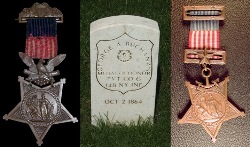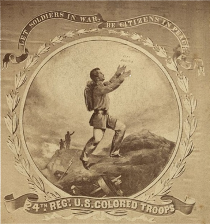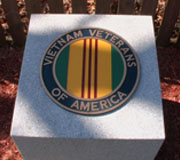History: Notables
Medal of Honor Recipients
Unlike today, early U.S. military practice did not include awards and medals. The Civil War changed this. Americans fighting on both sides led government officials to recognize this bravery. President Abraham Lincoln signed a bill creating 200 medals of honor in late 1861. From this came the Medal of Honor, today the highest commendation for military service. The medal design, eligibility for it, and recognition on a recipients' grave marker have all evolved since the Civil War. There are 433 Medal of Honor recipients interred at VA national cemeteries including 6 double recipients.

African American Veterans
National cemeteries were created in the 1860s to honor those who serve in America's armed forces. Individuals laid to rest and commemorative features in the cemeteries reveal the growing diversity of those who have answered the call of duty since the earliest conflicts. The ongoing fight for racial equality over the Nation's history is mirrored by the increasing contribution to the U.S. Armed Forces by racially diverse veteran activists, pilots, heroes, artists, journalists, and sadly, victims of this struggle. Their inspirational stories helped advance American civil rights. What follows are some accounts of African-American service from the Civil War through Vietnam as reflected in VA national cemeteries.
African Americans in Military Service: Civil War through World War I
African Americans in Military Service: World War II through Vietnam

Aviation and Space Veterans
NCA owes its origins to the Civil War, as does the Signal Corps, U.S. Army. Airborne communication of military information started with air telegraphy, balloons, and Zeppelins before World War I. In the twentieth century, servicemembers piloting fixed-wing aircraft, helicopters, and supersonic jets ushered in the U.S. space program. We dedicated Cape Canaveral National Cemetery on November 20, 2015, in recognition of these men and women.

Hispanic Veterans
During Hispanic Heritage Month (September 15 to October 15), NCA highlights the long tradition of military service by the Hispanic community. Hispanics have contributed to military successes since the settlement of the Southwest Territories, including the "Bushmasters" during World War II and the Puerto Rican Borinqueneers beginning in World War I.

Native American Veterans
During U.S. westward expansion in the nineteenth century, most wars pitted American Indian tribes against one another and the Army. However, tribesmen also served alongside white and black enlisted men and officers — an estimated 20,000 during the Civil War. From the first American Indian to graduate from West Point in 1822 to specialist Navajo Code Talkers in World War II, American Indians also had to overcome racial discrimination in order to serve our nation. Many are buried in NCA cemeteries.
American Indians in Military Service
American Indian Code Talkers in WWII

Vietnam Veterans
In recognition of the Vietnam War, the Department of Veterans Affairs (VA) designated March 29, 2016, as the day to express gratitude to this generation of Americans who have "borne the battle," and acknowledge those now interred in its national cemeteries. VA National Cemeteries contain twenty-seven monuments, and the graves of thirty-eight Medal of Honor recipients from the Vietnam era.

Women Veterans
The range of women buried in VA national cemeteries is impressive: women who served in every branch of the military, spouses and some wives who literally followed their husbands into war, as well as nurses, civilian employees, spies, and elected officials. These women also represent the diversity of America, challenging gender and racial barriers. Learn more about women and our national cemeteries:
Women and VA National Cemeteries
Authorizing Women in Military Service: Nursing to Combat
See Where They Are Buried (Link to Story Map)*

Note: Find more notable Veterans and learn about their stories by visiting individual cemetery pages.
* External Link Disclaimer: This page contains links that will open in a new tab and take you outside of the Department of Veterans Affairs website. VA does not endorse and is not responsible for the content of the linked websites.

















